Beer Tasting 101: How to Tell the Skunky From the Merely Funky
Figuring out when something's gone wrong vs. just not liking a beer.
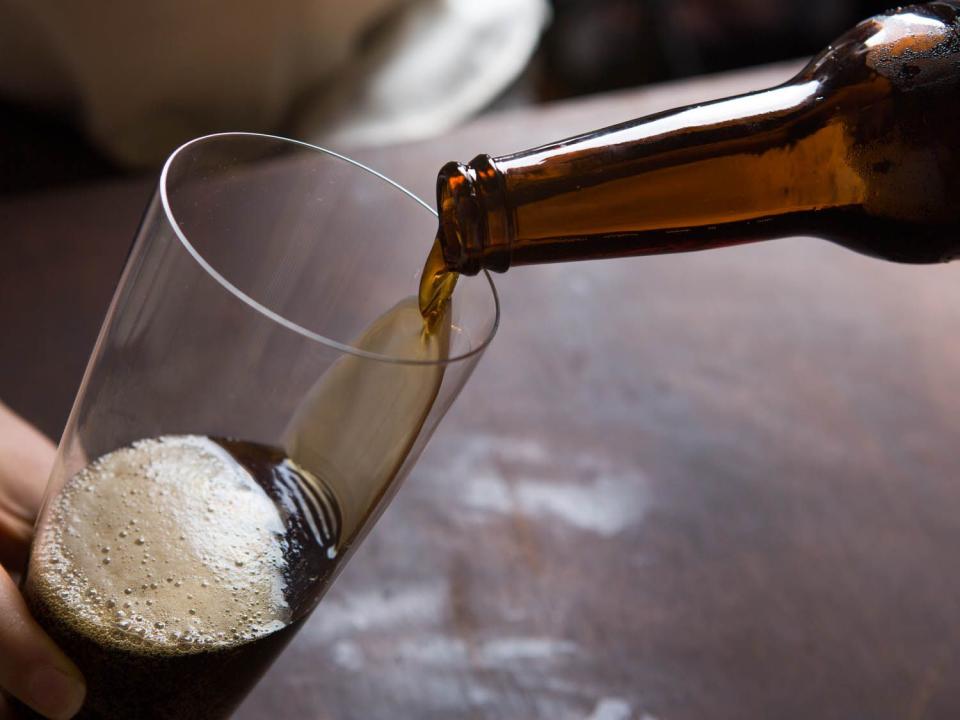
Serious Eats / Vicky Wasik
As far back as recorded history reaches—or at least since Rush sang "Working Man"—we as a species have extolled the virtues of that first cold, delicious sip of beer. But drink enough beers and eventually you'll hit the worst-case scenario: You select a beer from countless options, crack it open, take that first sip, and...it's terrible.
With hundreds of new, unfamiliar craft beers on shelves these days, a lot of people tend to assume they've chosen the wrong brand when they get a taste of something they don't like. Rather than complain (and subject themselves to a salvo of "actuallys" from bearded internet gentlemen), they'll go back to what they know. Their spirit of adventure will break, and they'll stop trying new beers altogether. Tragic.
But there's a difference between not liking a brew because of the way it tastes and not liking a beer because something has actually gone wrong in the bottle.
"I Hate This" Versus "Something Is Wrong With This"
There's a lot to love about the craft beer scene, but even its staunchest advocates would admit that it can be a little off-putting to the newly inducted. The sheer number of beer styles out there can be intimidating, but they're also useful designations. Beer style guides, whether they're put out by the Brewers Association, the Beer Judge Certification Program, or the team here at Serious Eats, can tell you what ranges of flavors and aromas to expect in any given style of beer—from the hoppiest IPAs to the regional German styles, like dunkels, bocks, and märzens, that have remained largely unchanged for generations. I spoke to Lucy Burningham, Certified Cicerone, Serious Eats contributor, and author of My Beer Year, about the importance of trying a lot of styles to find the flavors that are up your alley. "I always tell people who are just getting into beer to take your beer with a grain of...I guess not salt, but at least perspective. There's an extreme range of flavors, sometimes even within a style, and especially in American-made beers," Burningham says.
But sometimes, the problem isn't that the beer doesn't suit your taste; it's that something went awry in the process that turned the sack of malted grain on the brewer's shelf into the cold, inviting liquid frothing in the glass in front of you. If you want to cultivate a broader palate, it's worth knowing how to tell the difference between a beer that's skunked—due either to a fault in the brewing process, or to the way the beer was packed, shipped, or stored—and a new flavor that you're not digging. That can translate into knowing when to give up on a style of beer, and when it's just time to find a new neighborhood bar.
The good news is that, as bad as they can taste, off flavors in beer aren't going to kill you, which means you shouldn't be afraid to experiment. By all means, pop the top on that can of World's Fair Beer from 1982 (Knoxville!). You'll be fine, even if your taste buds momentarily suffer.
Here's how to navigate what you're tasting and, with any luck, open yourself up to something new to love.
Sought-After Flavors That Aren't for Everyone
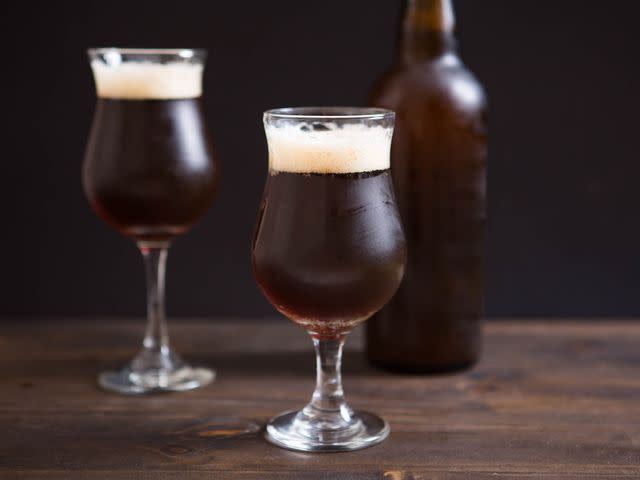
Serious Eats / Vicky Wasik
"This has gone...sour. Wait, does beer go sour?"
Smells/tastes like: cider vinegar, green apple
You'll find it in: Flanders red, fruit lambic, gose
The reason: lactic acid, acetic acid
While the history of European and American brewing has largely been one of "Hey, people seem to like this lager stuff!", the Belgians never fully lost their weird streak. Sure, they ship a ton of Stella Artois, but their brewers have been using open-air fermentation and wild-yeast methods for centuries. And with those methods, some fairly unusual flavors come into play—tart, acidic, and sour among them. If you're getting sourness from a macro-brewery lager at a bar, it's a huge red flag (see below, in the "Jolly Rancher" section), but in select styles, sour notes are so prized that beer fans will fly to Europe to experience them fresh from the source. And American brewers, as they're wont to do, have taken the best of what they love about European beers and begun producing their own sours.
"I've noticed the word 'sour' is so off-putting to people," says Burningham. "And if you ask, 'Hey, do you like sour beers?', their instinct is to say, 'No, because that sounds disgusting.' But it's just one element alongside what else is expressed in the beer. That sourness is there with lots of flavors of dark fruit, or adds a brightness to richer, thicker-bodied brews."
The word "sour" itself is often presented as something to endure, rather than enjoy. But in these beers, sourness provides an accent to fruity, refreshing flavors. While some sour beers can be astringent or overly acidic, the best ones offer a layered drinking experience that makes your everyday beers seem a little by the book.
"This is so bitter. What's up with that?"
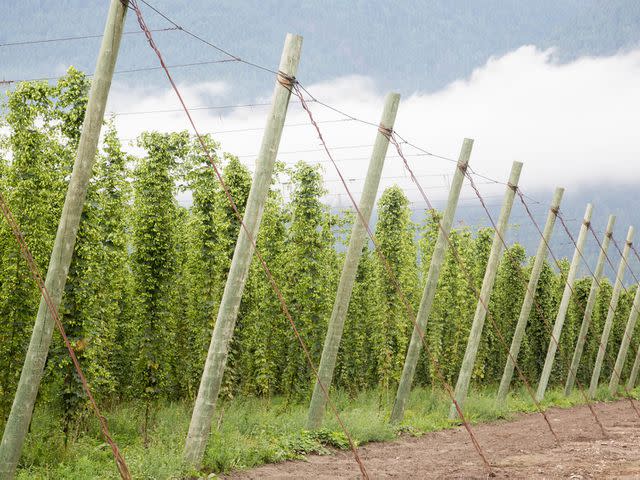
Serious Eats / Rabi Abonour
Smells/tastes like: herbal, citrusy, piney, woody, bitter
You'll find it in: India pale ale (IPA), double IPA, barley wine
The reason: hops (or, more specifically, the alpha acids they contain)
Most people have had a beer that was heavy on hops—the dried flowers of the hop plant—and found that it wasn't for them, often because it was too astringent or too floral for their taste, or simply poorly balanced. A lot of craft brewers find that the particular piney, citrusy characteristics of American hops give their beers a unique sense of place, and a natural spirit of competition within the industry has led to a hop arms race of sorts, resulting in some products with a fairly extreme flavor profile. It's understandable that some beer drinkers would come to associate the words "pale ale" with unremitting harshness.
"I'm constantly talking to people who say they don't like hoppy beers, and I understand why," Burningham says. "Here in the Pacific Northwest, it's easy to get burned by hoppy beer. You order just a regular IPA, and it just completely destroys your palate."
But not all brewers aim to attack your taste buds with IBU bombs. ("IBU" stands for "international bitterness unit." A light lager has between eight and 12 IBUs, while an American IPA has 40 to 70, and 100 is the theoretical limit of perception for most drinkers.) Different brewers use vastly different strains of hops to add bitterness, to balance the sweet malt flavors from the wort (that's the grain-infused liquid that later ferments to become beer), and for their natural preservative qualities. There are dozens of unique types, with new ones in development all the time, and they all contain varying levels of bitterness-causing alpha acids. British hops are known for their earthy qualities, while German hops tend toward herbal, even mint-like flavors. American hops vary widely, but the most beloved ones feature aggressive citrus and pine flavors. Though England invented the IPA, its beers are much milder than the ones now made on the West Coast.
Still, even among American brewers, Burningham says, some significant style differences are emerging that should encourage anyone who's given up on pale ales to reconsider. "There are really lovely IPAs that are very balanced and far less bitter than people expect. Some people talk about 'hops' as a single flavor, but there are a lot of different flavor profiles depending on which type the brewer uses," she says. "Some are tropical, some are citrusy, and some are kind of herbal. And you have to remember that even high-IBU beers can be balanced out by character from the malt."
"This smells like hard liquor."
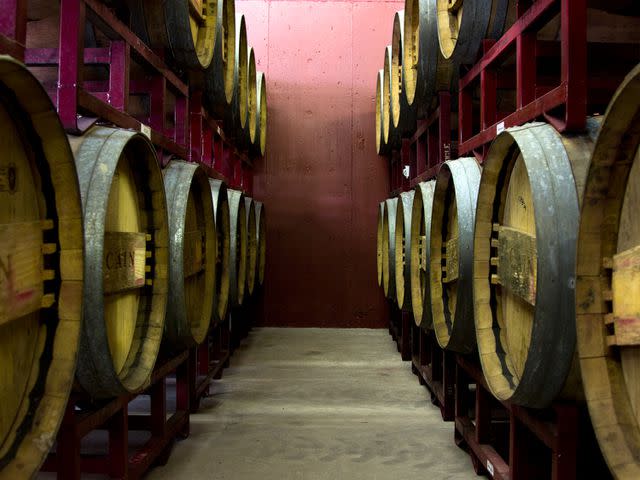
Serious Eats / Dustin Hall
Smells/tastes like: vanilla, coconut, oak
You'll find it in: stouts, porters, dubbels, and other barrel-aged beers
The reason: oxidation, aging
Time and oxygen both significantly mellow out a beer's hop bitterness and aroma. This type of beneficial oxidation occurs in barrel-aged beers, as the porous wood of the barrels lets in oxygen and contributes flavors of its own. So what starts life as a toasty, coffee-like stout, chocolaty porter, or sweet, fruity dubbel can, in the end, remind you of port or sherry, sometimes with a little residual warmth from the elevated alcohol content. The barrel brings flavors from both the wood and any alcohol lingering in it, which is why many brewers like to experiment with the same beer in different repurposed barrels, including those used for rum, wine, and whiskey.
"I think a lot of beginning beer drinkers might be really surprised to find that sherry or port is an acceptable and desirable flavor in many beer styles. Oxidation is generally treated as a bad thing in brewing (see below, in the "Wet Newspaper" section), but in a few beers, it's great," Burningham says. "They're oxidizing, but it's part of their beauty and flavor profile, and it turns them into a sipping, sherry-like beverage."
Off Flavors From Brewery-Side Problems
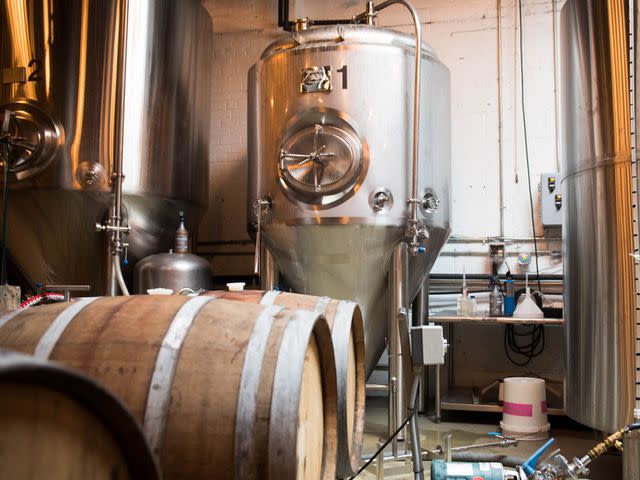
Serious Eats / Liz Clayman
If you've ever forced down a bottle of a friend's bad home brew, you're already familiar with some of the ways the process of making beer can go wrong. Certain strains of yeast can have the terrifyingly fickle temperament of a stage mom or a hockey dad, and without perfect conditions, flaws are bound to arise. I spoke with Hagen Dost, co-owner and brewer at Dovetail Brewery, about some of the most common brewing problems and the off flavors that can result.
"Someone dumped vegetable peelings in this."
Smells/tastes like: old creamed corn, shellfish burps
The reason: dimethyl sulfide (DMS)
DMS is created when malt, the grains that form a beer's base, is heated. If the brewer doesn't bring the wort to a solid rolling boil, or if the wort isn't chilled quickly enough after boiling, you'll get this sulfur-y compound in your beer. It's more common in beers with lighter malts, such as pilsners. "If you smell creamed corn, the boil never got vigorous enough, because that's where [the DMS] cooked off," Dost says.
"This smells like an abandoned movie theater."
Smells/tastes like: rancid popcorn butter, a Werther's Original handed to you by a grandpa ghost
The reason: diacetyl
Diacetyl is a buttery/butterscotch-y aroma that's put out by yeast during fermentation. Normally, it's reabsorbed by the yeast during the secondary fermentation part of the brewing process. But if the beer is siphoned off of the yeast for packaging too early, the diacetyl remains, and you get this I-Can't-Believe-It's-Not-Butter awfulness. Many brewers take steps specifically to avoid any diacetyl in the finished product.
"What we do as brewers is something called a diacetyl rest," Dost says. "Our lager starts at 5°C (41°F) and slowly rises to about 9 to 10°C (48.2 to 50°F) over the course of about four days. After about five days, we bring it up to around 12°C (53.6°F), and it rests for about four days. And at that time, the yeast takes the diacetyl back in and kind of scrubs the beer of that buttery flavor. The longer you leave it at that slightly higher temperature, the more of it the yeast takes in, until it's completely gone."
Though diacetyl is a very aggressive flavor, some people have a genetic quirk that means they can't taste it. If you want to encounter it in the wild, you'll find it in small amounts in Pilsner Urquell and many English ales, where it's considered acceptable.
"Is there a Jolly Rancher in this?"
Smells/tastes like: green apple, latex, hospital paint
The reason: acetaldehyde
When a beer is fully fermented, all the acetaldehyde, a chemical that's created by yeast as a precursor to ethanol, is turned into alcohol. But if the yeast doesn't get enough time to finish converting sugar into alcohol, you're left with this unpleasant flavor, and a product that some people call "green" (as in young) beer.
"Acetaldehyde is most commonly referred to as smelling like a freshly painted room or green apple, but everyone gets it a little differently," Dost says. "It goes away with age and maturation, or a long lagering [storage and mellowing] process. The yeast takes up the acetaldehyde and converts it to ethanol, because it's doing everything it can to stay alive."
If you find yourself with a mouthful of paint-flavored Jolly Rancher, the beer was probably rushed into packaging before it was ready. You'll experience this sometimes at new breweries, where the need to sell beer may win out over quality control.
Off Flavors From Storage and Service Problems
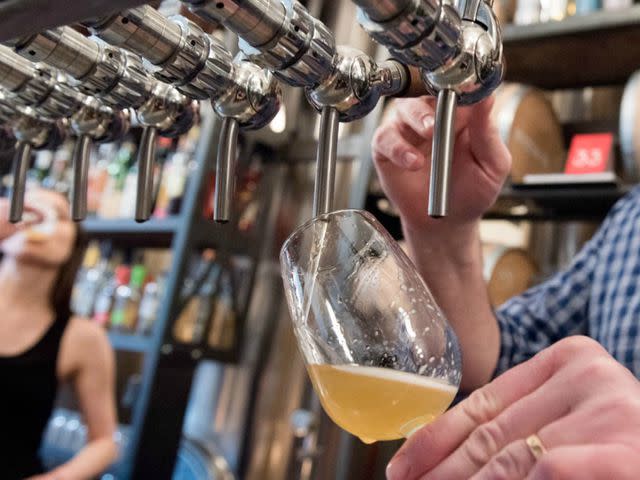
Serious Eats / Liz Clayman
It's hard to peg a bar's beer storage and service quality before you've had a few beers there. The sports bar down the street might brag of its 200 bottles and cans, but if those beers sit next to the furnace for six months before they're dusted off and thrown in the cooler, you might run into unpleasantness. Or, to save money, a bar may not clean its draft lines and taps for months, thinking no one will notice.
If beer is handled, stored, or served poorly, the flavor's going to suffer, and you don't have to be any kind of expert to notice. I spoke with Drew Larson, who builds and maintains draft-beer systems as the owner of Leaders Beverage, and Michael Roper, who owns the Hopleaf Bar in Chicago, a well-regarded destination for America's beer obsessives, to learn more about what can go wrong on the service end.
"This tastes like old, wet newspapers."
Smells/tastes like: wet cardboard, old newspapers, museum despair
The reason: trans-2-nonenol
What you're tasting here is the impact of age and/or oxygen. Beer (especially light beer, like lager) doesn't last forever. Oxygen will eventually get to it, especially in bottles and corked beers, and make it as appealing as a mushy old Reader's Digest fished out of the basement by a flood-cleanup contractor.
Temperature fluctuations are another enemy of beer freshness. If the beer's stored in a basement along with the compressors for the beer coolers, it's aging and breaking down so quickly that you might think it chose the wrong Grail.. "There's radiant heat that comes out of compressors, and there's almost never any ventilation. So in the summer, when the coolers are working their hardest, it can be over 100 degrees in the basement," Roper says. "We ended up moving our compressors all the way to the roof, where they could do no harm."
"Is there a skunk around here?"
Smells/tastes like: Your dog got into a fight under the porch, and it's time to prepare a tomato bath.
The reason: 3-methylbut-2-ene-1-thiol (3MBT)
When beer is exposed to the sun at some point after packaging, the bitter alpha acids from the hops react to the light by forming the same chemical found in a skunk's spray—and creating what's referred to as "lightstruck" beer. Clear and green bottles let in the wavelengths of light (from both sunlight and fluorescent light) that skunk beer. So why do brewers still use them? Marketing, mostly. Try comparing the flavor of a Heineken in a bottle versus one in a can—the beer gets a bad rap in large part because of that green bottle that's so critical to its image. It's a common belief in the beer industry that lime became the classic accoutrement for a Corona because its flavor tempers the skunking effects of exposing the clear bottle to sunshine—so classic, in fact, that a lime wedge in the neck is now crucial to the beer's beachy brand identity.
"Fluorescent tube lighting emits the worst kind of light for skunking. So, unless those clear or green bottles are painted or wrapped, they're going to get lightstruck somewhere along the line," Roper says. "A lot of places put filters over the lights in their cooler to block that spectrum of light."
If you need a refresher on skunky beer, this is the easiest off flavor to experience—just pour a nice tall glass of a light beer, like pilsner, and walk into the sunlight with it. In a minute or two, the skunk-causing reaction will already be under way, and it'll keep getting worse, especially in hoppier beers with more alpha acids.
If you do end up with a skunky beer at a party, Larson says, it's worth remembering that humans get acclimated to the smell of 3MBT very quickly: "That's why we don't have stadiums full of outraged people." Lightstruck beer isn't ideal, but it beats wine coolers.
"Ack! Is there vinegar in this?"
Smells/tastes like: a little bit of your popcorn nightmare above, with a mouth-punching tang of unwelcome vinaigrette
The reason: acetic acid (and diacetyl)
Either the beer is infected, or the draft lines are. A bacteria called acetobacter, along with oxygen, turns ethanol into acetic acid, which is essentially vinegar. Per the Brewers Association, bars should clean their lines every two weeks with a caustic solution, and do a heavier cleaning with an acid-based solution every 90 days. Not that they always do—draft-cleaning laws, where they even exist, are fairly toothless. For example, Illinois state law requires that draft lines be cleaned every two weeks, but, according to Roper, inspectors spot-check the lines only once a year, with a bar napkin. If you fail, you get a ticket and a fine of between $100 and $500—a cheaper option than replacing draft lines and regular cleaning. So it's ultimately up to the bar owner to set the standard for maintenance.
"The lines that run from the keg couplers to the draft tower are flexible, so they're also porous. Beer lines can soak up flavors, aromas, and more bacteria," Larson says. "You'll see something called 'beerstone'—calcium oxalate—build up in the lines and harbor diacetyl and bacterial flavors. And even before that, dirty lines will dull the crisp hop notes of a beer."
How to Treat Your Beer Right
There's not a lot you can do about a poorly brewed beer, but you can take steps to make sure you're buying fresh beer, and keeping it that way as long as you can.
1. Check the date code. Some breweries give you packaging dates; others suggest a "best before" date. Either way, look for a traditional code (like 041517, meaning April 15, 2017) or a Julian date code (which gives two digits for the year and a number between 1 and 365 for the bottling day—e.g., "007-17" for January 7, 2017). Some breweries have their own specific date coding systems, in which case you can either call the brewery or buy something else and save yourself the hassle.
2. Don't buy hot, don't buy old. If you're shopping for beer and one of your choices is stored in the sunlight or covered in a fine layer of dust, it's not really a choice at all. Beer can pile up, stock may not sell quickly enough, and the proprietor may be of the mind that someone will eventually buy it. Don't let that person be you.
3. Keep it cold. The general rule, adopted from research done by MillerCoors, is that beer will age about the same amount in three days at 90°F, 30 days at 72°F (around room temperature), and 300 days at 42°F (refrigerated). Not every beer behaves like Coors, but it's a great basic guideline to follow, especially since hoppier beers lose their aroma and bitterness quickly. Storing beer cold will give you the freshest results.
4. Remember, it's not wine. Yes, there are some folks out there who hoard and jealously guard their beer collections, like Smaug on his gold pile. But pretty much every beer is at its best for drinking the day it's released from the brewery, so leave the hoarding to the lonely beer dragons. Aging most beers will give you one result—a noticeably worse version of that beer.
5. Keep it out of the sun. According to the experts, even brown bottles will eventually skunk if exposed to too much light. Treat your beer like something that will crumble into nothingness in the harsh light of day—a Transylvanian count, for instance, or Sam Worthington's career as a leading man.
6. Use a clean (unfrozen) glass. When it's time to drink, pour the beer into a glass to experience its full aroma and flavor. While your tongue can pick up on only a handful of flavors (sweet, sour, salty, bitter, and umami), there are hundreds of aromas that help form the overall taste of your beer, and a glass will bring a lot more of those aromas to your nose while you're tasting. And, while frosted glasses are a nice idea in theory, the ice crystals will turn your beer into foam and make it taste like the freezer—specifically, the freezer that you know you should probably clean more often.
May 2017
Read the original article on Serious Eats.

